
M30 500cc Magnesium SOHC (and early DOHC) Crankcases - First Set Finished
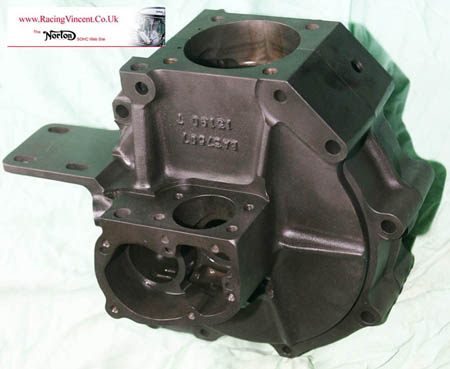
Completed M30 500cc magnesium crankcases - ready to start assembly of a first 'test bed' engine which hopefully we will have complete towards the end of 2016
Click on pictures through article to see supersize version
Crankcase Progress and Next Steps
Well it has been a long and difficult process, but I am pleased to report that we have now completed our first set of SOHC (and early DOHC) M30 pre-Featherbed magnesium racing crankcases, ready for testing.
These crankcases were of the type that Norton used on their competition bikes from approximately 1934-35, through to when they moved over to the very different Featherbed Manx type in approximately 1950. It was 'Racing Internationals' offered to customers with this type of magnesium alloy crankcase that resulted in Norton’s first using the description ‘full manx racing spec’ to describe the specification of an individual bike in the Norton records, which was later shortened to the legendary monogram of ‘Manx Norton’. Having previously been lucky enough to peruse the original Norton records, I can see that surprisingly this description was used as early as 1936, possibly earlier.
If all goes well we will be manufacturing these crankcases in two variations – pre-war type (without pinch bolts around the circumference) and post-war type (with pinch bolts).
So far I have to say that we are really pleased on how they have turned out – first of all, I am going to stick my neck out and say that I believe they are virtually indistinguishable in appearance from originals - even down to the correct casting numbers being present and upside down as per originals, but also the quality of the machining – for which I must thank my good friend Rob Norton, an accomplished CNC engineer – more used to machining exotic aeronautical parts.
This first set is now destined to be built into a pre-war SOHC racing engine, which will be of mid 1930’s SOHC ‘Works spec’ configuration, slightly oversize (approx 530cc) and running on methanol.
Although not getting much available time at the moment, I hope to have this engine assembled and ready for testing in the next 3 months, and we will be giving some heavy use on the track before confirming all is well and we go for our first production run – probably 10 sets at a time.
While I am now working on assembling this first engine, Rob has commenced machining of a second set – to post-war specification, so we can confirm the jigs and fixtures we have made hold good and the post-war differences are accounted for.
I am expecting these to be built into my original 600cc 1949 Manx sidecar outfit – the original crank for which has already been re-built.
If you are interested in putting your name down to reserve a pair of the first 10 sets, email me on the normal email address: paul.norman@racingvincent.co.uk
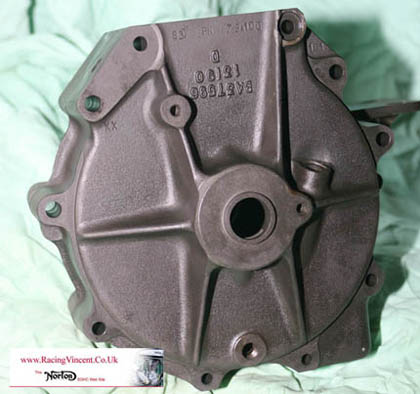
And drive side of the same crankcases
You will notice there is no webbing around the mid circumference of the crankcases, i.e. in the shape of the Norton chaincase - which the International roadgoing crankcases had. Other than the black finish on magnesium crankcases, it is this feature that differentiates original Norton competition M30 (i.e. early Manx Grand Prix Spec) crankcases from International and CS1 crankcases
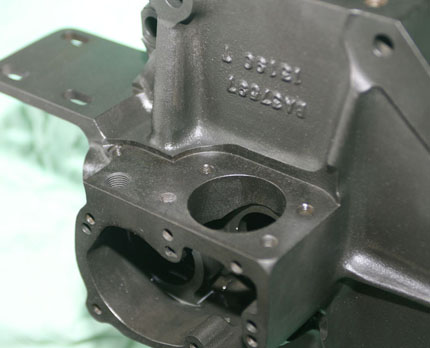
Bevel chamber and magneto platform shown here - I am pleased to say both pretty much identical to original Norton crankcases. Although not as complex as some modern multi-cylinder crankcase patterns, the Norton SOHC crankcase has quite complex oil galleries, allowing a by-pass route controlled by a ball valve - all this has been faithfully reproduced
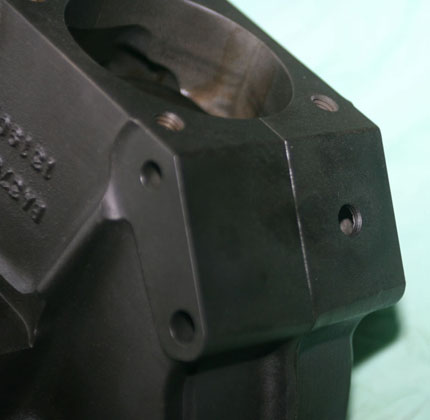
Original M30/SOHC Manx crankcases will normally found with either one or two breather union holes on the front engine plate mount. We have made this with the more normal single valve fitting on the left
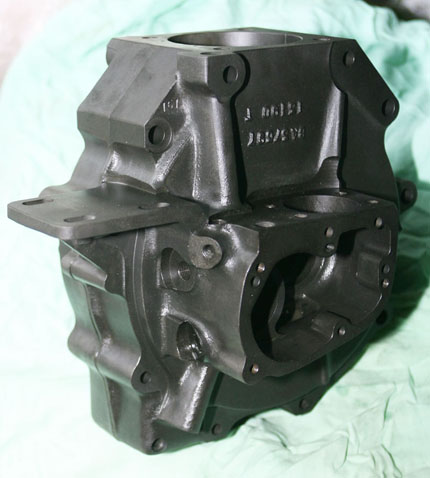
Another shot of the all important oilways - pretty much indistinguishable to the original Norton cases these were based on. Top union on left of bevel chamber is for pressure release valve, then oif feed/return below that. Notice lower union is angled inwards - this was a mod made very earlyin the Norton M30/Manx development life (i.e pre-war) to help prevent kinking of the oil pipe, which I assume was an issue with the first parallel versions
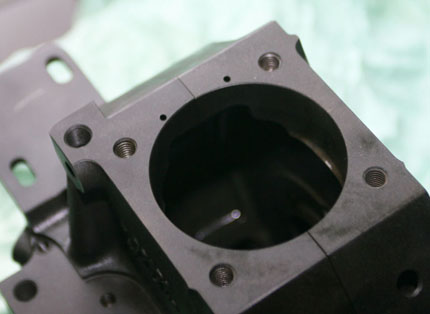
Barrel opening shows oilways to the rear cylinder wall. The oil feed up to the cambox looked slightly different on the SOHC Manx/M30 crankcase when compared to the International crankcase - in that there was no provision for a pressure indicator (this was an extra boss on International crankcases at the rear of the bevel platform - on a SOHC Manx there was just a provision for a breather union - just visible on these M30 crankcases on the lower left
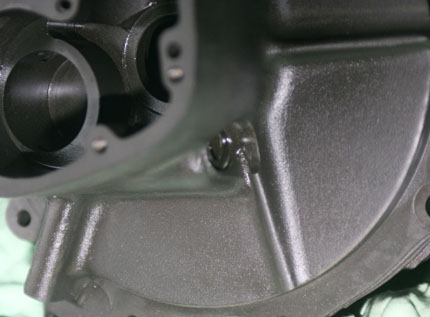
This picture shows the provision for the lower bevel filter bolt (and needless to say, when we do offer these crankcases for sale, we will also be able to offer all the fittings needed. This picture also shows the important oil pump housing - which is machined to take 'standard' size Norton 3 channel SOHC/DOHC pump
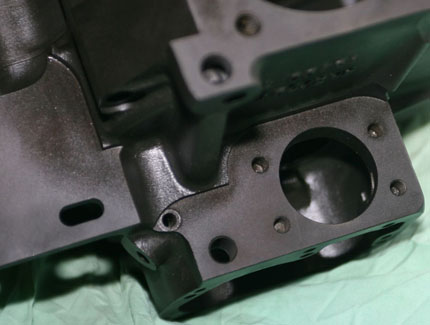
And another photo looking down on teh magneto platform and bevel chamber platform. Slightly wet look is because they have been sprayed in protective Duck Oil - always a good thing to do with magnesium castings, even when crhomated as these ones are.
By the way - although I cannot take any personal credit for the machining, as these photos confirm - I can say that our machinist Rob (who normally works in the aeronautical industry) has done a fine job on them - finish is excellent
. . . And some Worik In Progress Pictures
And here are a few photographs taken after completion but before the final re-chromating process. Also a few other pictures which you may find interesting:
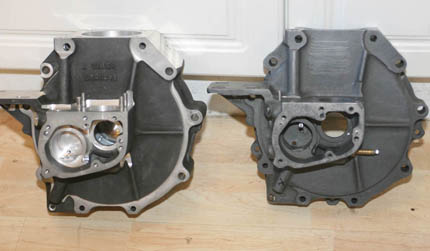
Our M30 timing side crankcase on the left and original Norton M30/SOHC Manx Norton crankcase on the right (I am not allowed to refer to mine as Manx as someone well known owns the trademark to that name).
As I hope you can see - although our's had not been re-chromated at this stage, they look effectively identical to the origianl crankcase.
There are actually a couple of detail differences: 1. Our set have the correct inverted crankcase casting numbers above the bevel chamber - the original set interestingly have had these scrubbed off - sometimes this was done othertimes it was not. 2. Our set on the left do not have 'pinchbolt' lugs at 3pm, 6pm, 9pm around the circumference, indicating our set are 'pre-war' specification, while the original crankcase is post war. We are already starting to machine our second set of crankcases which are of 'post-war' specification. Eventually we will offer both configurations
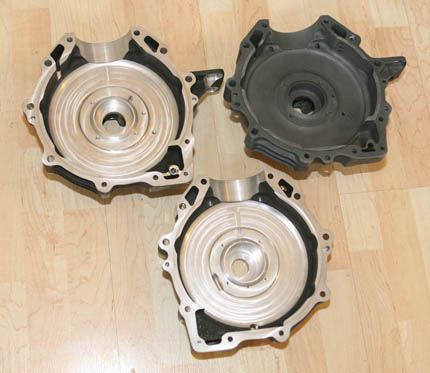
This photo shows the internal machine that has taken place - mains housings, crankcase walls and crankcase mating faces. Obviously, the mains housings could not be machined until the outer mating faces were machined - then both housings were machined together with the crankcase half's bolted together.
Compare the new crankcases with the original crankcase on the top right
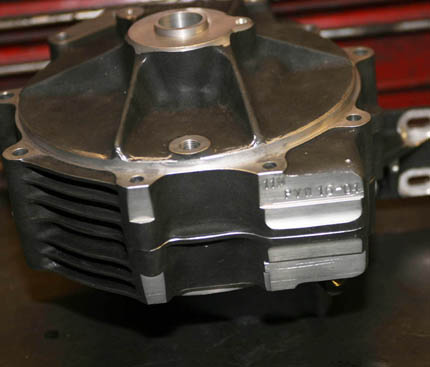
You can see the finning at the base of this crankcase, as well as the filleting at the rear of the sump. As well as the norrmal Norton engine stamps, I have also included a numbering serial number at the base of our own - to identify in the future
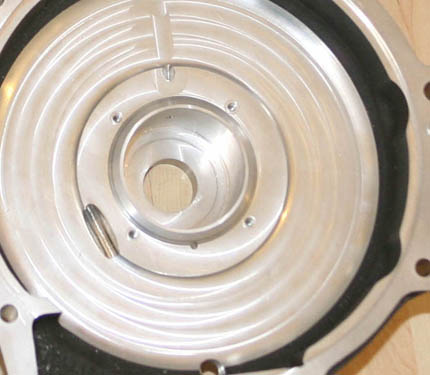
This picture clearly shows the circular milling motion around the inner crankcase walls, as well ad the fully machined main bearing housing. The exit at teh lower left of the main bearing housing is where the one way breather valve screws in

Milling in progress. Look at the large collection of magnesium alloy swarf that has collected in the crankcase centre - put the right kind of heat and combustion into that little pile and you would get the most impressive and intense fire - as I found just recently when welding up a magnesium cambox!
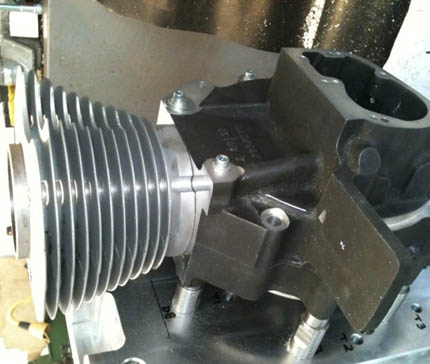
Rob had to make a number of jigs for holding the crankcases - some of them impressive pieces of engineering in themselves. This large slab of aircraft quality alloy was one of them - with pillars for holding the cases in situ while boring the mains. Also, trial fitting of an original pre-war Manx round barrel at this point
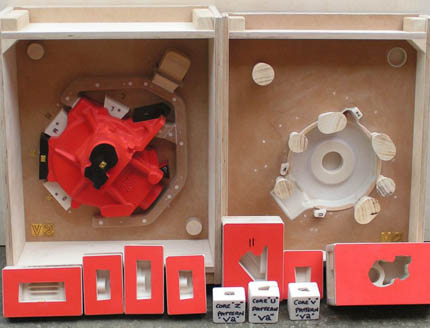
I did publish a picture of these a couple of years ago in a Newlsetter - but worth showing them again - these are the timing side boxed casting patterns and core boxes. Who said that pattern making was a lost art!
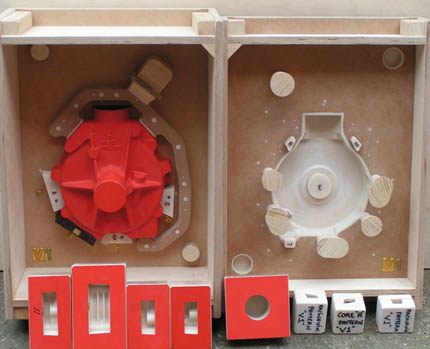
And here are the drive side boxed patterns. The channel running around the red pattern on the left sandbox is a 'runner' to allow the molten magnesium alloy to run in from more than one direction.. When looking at sand pattern boxes you need to remember they will be used for pouring hard setting sand into, which when set will form the moulds for metail to be poured into
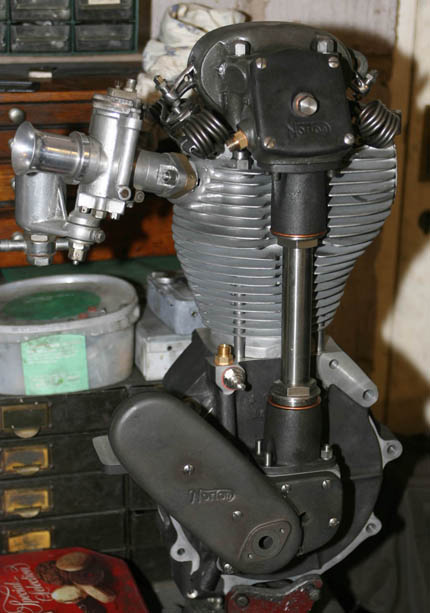
Trial build of engine using original pre-war Manx barrel/head/cambox shell - but pretty much everything else from our parts. At this stage crankcases were not quite complete - magneto platform still to be done, but gives a good idea what first 'test' engine will look like - close to a 'Works' spec 1935'ish engine. We are using slightly oversize forged Omega alchohol piston with Longstroke Manx cams. Engine will be ran on methanol and approx 540cc. Just waiting for new crankshaft to be completed, using Carillo conrod
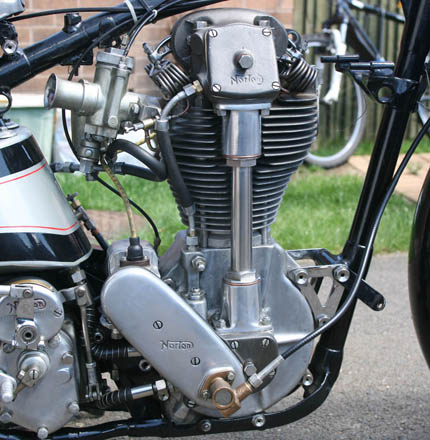
As a comparison - this is the methanol engine in my 1938 Racing International which will be used as a test donkey for the new engine. This engine is of similar internal specification to the new one, but uses original aluminijm International crankcases. I will need to make up custom front engine plates, as pre-war Manx frames have a front engine lug one inch higher than International frames (see photograph of my 1938 Big Plunger Manx to see the difference)